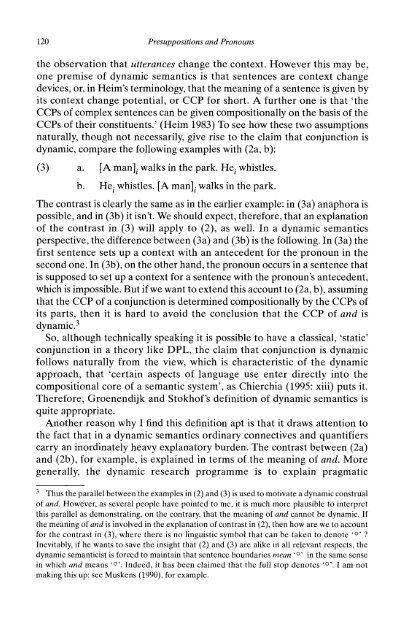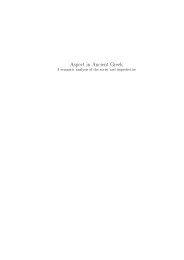Presuppositions and Pronouns - Nijmegen Centre for Semantics
Presuppositions and Pronouns - Nijmegen Centre for Semantics
Presuppositions and Pronouns - Nijmegen Centre for Semantics
You also want an ePaper? Increase the reach of your titles
YUMPU automatically turns print PDFs into web optimized ePapers that Google loves.
120 <strong>Presuppositions</strong> <strong>and</strong> <strong>Pronouns</strong><br />
the observation that utterances change the context. However this may be,<br />
one premise of dynamic semantics is that sentences are context change<br />
devices, or, in Heim's terminology, that the meaning of a sentence is given by<br />
its context change potential, or CCP <strong>for</strong> short. A further one is that 'the<br />
CCPs of complex sentences can be given compositionally on the basis of the<br />
CCPs of their constituents.' (Heim 1983) To see how these two assumptions<br />
naturally, though not necessarily, give rise to the claim that conjunction is<br />
dynamic, compare the following examples with (2a, b):<br />
(3) a. [A manl man]. walks in the park. He t i<br />
whistles, whistles.<br />
b. He { i<br />
whistles. [A man]; L walks in the park.<br />
The contrast is clearly the same as in the earlier example: in (3a) anaphora is<br />
possible, <strong>and</strong> in (3b) it isn't. We should expect, there<strong>for</strong>e, that an explanation<br />
of the contrast in (3) will apply to (2), as well. In a dynamic semantics<br />
perspective, the difference between (3a) <strong>and</strong> (3b) is the following. In (3a) the<br />
first sentence sets up a context with an antecedent <strong>for</strong> the pronoun in the<br />
second one. In (3b), on the other h<strong>and</strong>, the pronoun occurs in a sentence that<br />
is supposed to set up a context <strong>for</strong> a sentence with the pronoun's antecedent,<br />
which is impossible. But if we want to extend this account to (2a, b), assuming<br />
that the CCP of a conjunction is determined compositionally by the CCPs of<br />
its parts, then it is hard to avoid the conclusion that the CCP of <strong>and</strong> is<br />
dynamic. 3<br />
So, although technically speaking it is possible to have a classical, 'static'<br />
conjunction in a theory like DPL, the claim that conjunction is dynamic<br />
follows naturally from the view, which is characteristic of the dynamic<br />
approach, that 'certain aspects of language use enter directly into the<br />
compositional core of a semantic system', as Chierchia (1995: xiii) puts it.<br />
There<strong>for</strong>e, Groenendijk <strong>and</strong> Stokhof's definition of dynamic semantics is<br />
quite appropriate.<br />
Another reason why I find this definition apt is that it draws attention to<br />
the fact that in a dynamic semantics ordinary connectives <strong>and</strong> quantifiers<br />
carry an inordinately heavy explanatory burden. The contrast between (2a)<br />
<strong>and</strong> (2b), <strong>for</strong> example, is explained in terms of the meaning of <strong>and</strong>. More<br />
generally, the dynamic research programme is to explain pragmatic<br />
3<br />
3 Thus the parallel between the examples in (2) <strong>and</strong> (3) is used to motivate a dynamic construal<br />
of <strong>and</strong>. However, as several people have pointed to me, it is much more plausible to interpret<br />
this parallel as demonstrating, on the contrary, that the meaning of <strong>and</strong> cannot be dynamic. If<br />
the meaning of <strong>and</strong> is involved in the explanation of contrast in (2), then how are we to account<br />
<strong>for</strong> the contrast in (3), where there is no linguistic symbol that can be taken to denote '0' '°' <br />
Inevitably, if he wants to save the insight that (2) <strong>and</strong> (3) are alike in all relevant respects, the<br />
dynamic semanticist is <strong>for</strong>ced to maintain that sentence boundaries mean '°' '0' in the same sense<br />
in which <strong>and</strong> means '0'. '°'. Indeed, it has been claimed that the full stop denotes '°'. '0'. I am not<br />
making this up: see Muskens (1990), <strong>for</strong> example.














